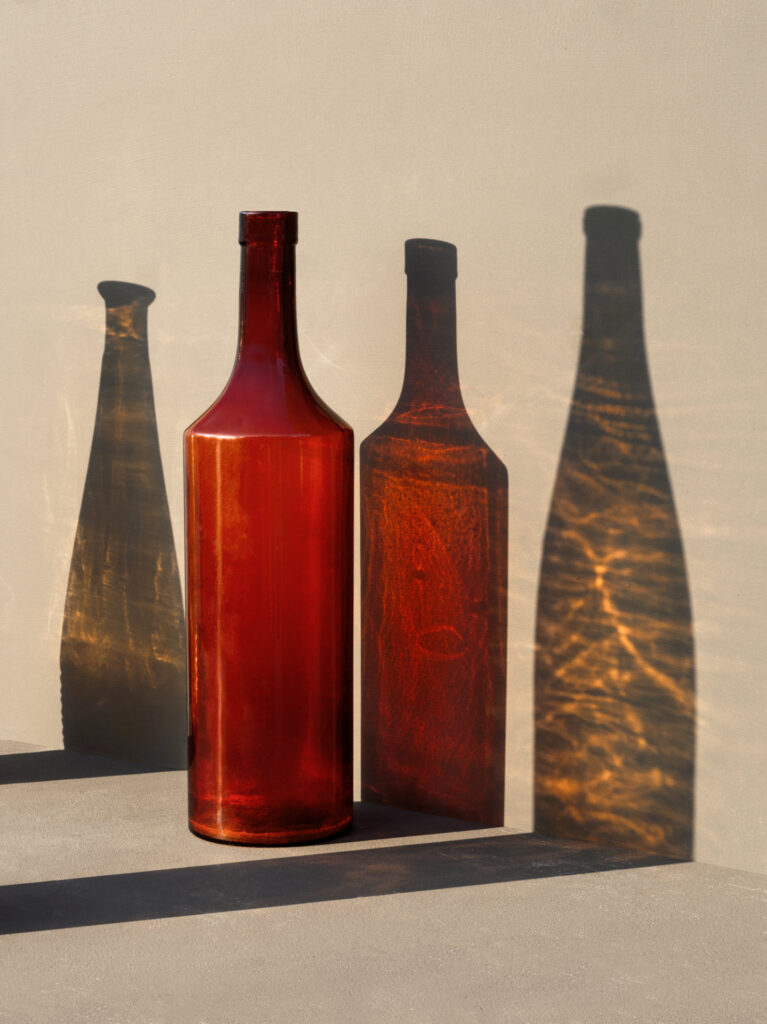



In his search for shadow, Hugo Thomassen found light. It is not the play of light that intrigues, but the richness of shadow.
The bottles are what they are, yet they inadvertently evoke associations. Are we looking at a nocturnal cityscape with figures? Are we witnessing a chance encounter, a moment frozen in time, or simply an elegant composition with one or more bottles as the photographic subject? The bottle as a shape.
In actual fact, the bottle has been constructed down in minute detail. Although the associations may suggest coincidence, the composition itself makes no such assumption. After all, it was built layer by layer. Painstakingly so. It is rich in its simplicity. No expense is spared. Each line is deliberate, considered. So much is expressed through so little.

Without warning, this piece sends you soaring into the void – at least it had that effect on me. The void in which there is no time, and the severity of silence reigns. From a compositional standpoint, you have no reference point for space and time. As such, you go on your instincts and create a story yourself. Or you experience it in a meditative sense.
What am I feeling? Is it abandonment, bottomless loneliness? Or am I experiencing silence, light, and intimacy? The image is poetic, still, melancholy, and harmonious. Reassurance emanates from the strict imposition of order. Coincidence is out of the question.
The meaning of the work is hidden in the order that it projects. The interplay of lines formed by light and shadows never becomes a labyrinth, instead forming a guide pointing out the right direction. The photo has a reassuring effect on me which does not indicate a lack of thought. It makes me wander off in my mind’s eye while deciding my own perspective.
This piece puts me outside of time. I can find no links to a memory, something which photography usually excels at. The image is new, though I believe I see a shade of art history through which the influence of Giorgio de Chirico, Morandi, and Night Shadows by Edward Hopper subtly shine through.
The photograph distils the bottle to its purest form. It lays bare its essence. An idea. Is it truth that we see? Reality being exposed? Or are these simply shadows created by shapes? It is this that Thomassen plays with. Is it a single photograph or a picture composed of several images, a multitude of shots? In a sense, the photographic image is attempting to transcend the flatness of the paper.
Photography is the means by which Thomassen explores the world. He exposes order in chaos or reveals an event through an ordering. He is the author of a visual story. His work is a narrative without words. It is excitement without something taking place. It represents an ode to emptiness, silence, and form. The bottle as the bearer of meaning.
Everything has been translated into a language that one does not necessarily need to understand, but that one feels. He finds beauty in the composition of things, of objects. Naturally, a bottle is just a bottle, but in a composition and in relation to other bottles, by sheer coincidence a story is created.
Thomassen brings light and shadow as nuances to that composition. He does not impose hierarchy onto the image. The background, the negative space, is just as important as the bottle. This piece is so streamlined that there are no secondary subjects. Light and shadow are of equal importance, because they need one another.
Hugo Thomassen provides a context to the bottles. It is up to the viewer to make a story out of them – or not, of course. Because what is simply a charming image to one may appear to another as a story about existence and appearances.








